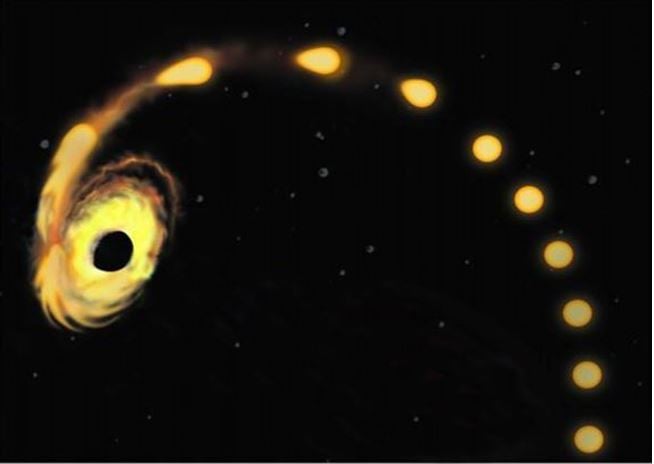A supermassive black hole was observed swallowing a star the size of our Sun and then spitting out a flare of matter moving at almost light-speed. The astrophysicists who witnessed the amazing event, led by a Johns Hopkins University scientist, wrote about what they observed in the journal Science.
Sjoert van Velzen, a Hubble fellow at Johns Hopkins, and colleagues said they tracked the star as it shifted from its customary path, slipped into the supermassive black hole’s gravitational pull, and was sucked in, as if by a giant vacuum cleaner.
van Velzen said:
“These events are extremely rare. It’s the first time we see everything from the stellar destruction followed by the launch of a conical outflow, also called a jet, and we watched it unfold over several months.”

A black hole is an area of space where gravity pulls so strongly that even light cannot get out – in fact, any kind of matter fails to escape its tremendous pull. The gravity is so strong because matter has been squashed into a tiny space. This may happen when a star is dying.
Because no light can escape from them, they become invisible, and are effective a void in the fabric of space.
Study confirms prediction made by scientists
This study appears to confirm the prediction made by astrophysicists that if a black hole is force-fed a huge amount of gas, which in this case was an entire star, then a fast-moving jet of plasma – elementary particles in a magnetic field (the fourth state of matter) – can escape from close to the black hole’s rim (event horizon).
van Velzen, who led the study and coordinated the efforts of the other scientists in the US, UK, Australia and the Netherlands, said:
“Previous efforts to find evidence for these jets, including my own, were late to the game.”
Scientists say supermassive black holes, the largest type of black holes – on the order of hundreds of thousands to billions of solar masses – are found in the center of nearly all massive galaxies.
A relatively lightweight supermassive black hole
This particular supermassive black hole, only around one million times the mass of our Sun, is a lightweight in the supermassive black hole league table. Even so, it still had the force to gobble up a decent-size star.
Scientists at Ohio State University, using an optical telescope in Hawaii, were the first to observe the star being destroyed. They announced their discovery on Twitter in December 2014.
After reading about the observation, van Velzen contacted a team of astrophysicists led by Rob Fender at the University of Oxford in England. Fender and colleagues used radio telescopes to follow up, and only just managed to catch the action in time.
By the time the action was done, the team had data from ground-based telescopes and satellites that gathered radio, X-ray and optical signals, providing an amazing ‘multi-wavelength’ portrait of the event.
Fortunately, this galaxy was relatively near
The galaxy in question is only about 300 million light years away, which is much nearer than others that scientists had previously studied in hopes of tracking a jet emerging after a star was destroyed. Its proximity, astronomically speaking, was a great bonus.
The researchers’ first step was to rule out the possibility that the light came from an accretion disk (a pre-existing expansive swirling mass) that forms when a black hole is sucking in matter from space. When it was ruled out, it helped confirm that the sudden increase in light from that galaxy was due to a newly-trapped star.
van Velzen said:
“The destruction of a star by a black hole is beautifully complicated, and far from understood. From our observations, we learn the streams of stellar debris can organize and make a jet rather quickly, which is valuable input for constructing a complete theory of these events.”
Van Velzen completed his doctoral dissertation last year at Radboud University in Nijmegen, the Netherlands, where he studied jets from supermassive black holes. At the end of his dissertation (last line), he said he hoped to discover these events within the next four years. Fortunately for him, it only took a few months after the ceremony for his dissertation defense.
Another team of scientists at Harvard University observed the same fate for the unfortunate star with radio telescopes in New Mexico. They announced their results online. In early November, both teams presented their results at a workshop in Jerusalem – when the two competing teams met face to face.
van Velzen said:
“The meeting was an intense, yet very productive exchange of ideas about this source. We still get along very well; I actually went for a long hike near the Dead Sea with the leader of the competing group.”
The study was supported by NASA, the European Research Council, the Netherlands Foundation for Scientific Research (NOW), the Australian Research Council, Alfred P. Sloan Foundation and , the International Centre for Radio Astronomy Research.
Citation: “A radio jet from the optical and X-ray bright stellar tidal disruption flare ASASSN-14li,” S. van Velzen, G. E. Anderson, N. C. Stone, M. Fraser, T. Wevers, B. D. Metzger, P. G. Jonker, A. J. van der Horst, T. D. Staley, A. J. Mendez, J. C. A. Miller-Jones, S. T. Hodgkin, H. C. Campbell, and R. P. Fender. Science aad1182. Published online 26 November 2015. DOI:10.1126/science.aad1182.
